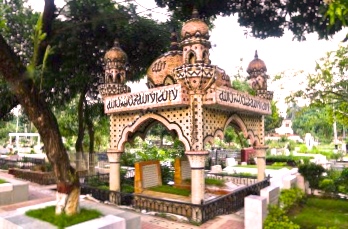“Kabir entered the room and approached his wife, and within a foot from her was struck by a hit of perfume that had him sneezing. Anwara backed away from him, moving toward the dressing table where she sat down on the small bench, lifted a silver-plated brush, and began drawing it through her hair. Teary-eyed, Kabir moved behind her. The two of them were framed in the oval mirror of the dressing table like a formal portrait, the pristine lady and her unkempt charmer.”
 From the opening story of the same name, Up in the Main House entertains and enlightens the reader with stories of life in modern day Bangladesh which recall the tales of servants and their privileged employers from colonial England years ago. Here, however, author Nadeem Zaman focuses on the lives of domestic employees in the capital city of Dhaka, most of them working for families of wealth who have employed them for nearly all of their lives. As in the typical British “upstairs” and “downstairs” stories, the servants often have clearer visions of what really matters and closer relationships with each other than what the reader usually sees from the often absent “upstairs” owners of these houses and their friends. As the servants share their daily lives and do their daily work, they reveal their genuine emotions and insights into real life. Vividly described and more casual than the formal stories of upperclass British servants, the lives of these Bangladeshi workers and their values become far more intimate and genuinely real than what most readers will expect, their lives complicated primarily by their sense of position regarding their employers.
From the opening story of the same name, Up in the Main House entertains and enlightens the reader with stories of life in modern day Bangladesh which recall the tales of servants and their privileged employers from colonial England years ago. Here, however, author Nadeem Zaman focuses on the lives of domestic employees in the capital city of Dhaka, most of them working for families of wealth who have employed them for nearly all of their lives. As in the typical British “upstairs” and “downstairs” stories, the servants often have clearer visions of what really matters and closer relationships with each other than what the reader usually sees from the often absent “upstairs” owners of these houses and their friends. As the servants share their daily lives and do their daily work, they reveal their genuine emotions and insights into real life. Vividly described and more casual than the formal stories of upperclass British servants, the lives of these Bangladeshi workers and their values become far more intimate and genuinely real than what most readers will expect, their lives complicated primarily by their sense of position regarding their employers.
The first story, “Up in the Main House,” from which the opening quotation is taken, features the love story of Kabir and Anwara, his wife, who are domestic servants, and their much older friend Ramzan, the caretaker of the large property from which their bosses will be away for at least a week. While continuing to live up to their household responsibilities, the servants are still enjoying their time off, especially Anwara. Early one evening, soon after their employers have left, Kabir enters the house at night to find Anwara in the master bedroom, reeking of her mistress’s perfume, standing in front of the full-size mirror next to the dressing table, and posing in one of her mistress’s evening costumes. “[Anwara] was exactly as she believed herself to be…a privileged, pampered ingenue whose graces were the envy of a thousand of her peers…whose affection would be the ultimate trophy of countless suitors, and the only thing she owed the world was to go on existing exactly as she was.” Leaving her to her fantasies, Kabir returns to Ramzan, who talks of the changes that have taken place in Dhaka during his lifetime, with the impossible traffic, the crowded sidewalks, and even the Banani Cemetery, now completely full. A crisis in which a young boy is caught on the wrong side of the perimeter wall, which he had climbed thinking he might be able to steal something, reveals Ramzan’s real sense of values and responsibility, at the same time that it also reveals Kabir’s “best talents” and true personality to himself and to Anwara.

A tamarind tree surrounded by open space in the countryside is an amazing sight for Hamid. Photo by Susana Tran.
The position of women as property in need of protection is highlighted in “The Caretaker’s Dilemma.” Abdul Hamid, a seventy-year-old caretaker, has worked for an especially wealthy family for thirty-five years. Married to a younger woman, he has three children, including two sons who have found good jobs in Dubai, thanks to the connections of his boss. Now it is time to find a “suitable” husband for his daughter, and it is the prospective groom’s family which makes the final decisions, often influenced greatly by the size of the bride’s dowry. In this case, the father of a potential groom, Helal Sobhan, has contacted Hamid to propose the wedding of his son to Hamid’s daughter. Hamid has savings for the dowry but needs help from his boss, who is willing to donate his mother’s wedding jewelry, since he has no one else to give it to. Hamid’s wife is less than happy with the choice of husband, whom they have never met, but she is also unsympathetic to her daughter’s reluctance about marriage, saying, “I got married. My mother before me got married, and so will your own daughter someday. Get up [off the floor].” Hamid makes the long trip from Dhaka to the countryside to discuss the potential wedding with the groom’s father. Sitting quietly under a tamarind tree and marveling at “so much uninterrupted land and sky,” the two men make final arrangements. As the wedding draws near, Hamid and his family learn of dire consequences for all of them if the wedding proceeds. He must act.
“The Holdup,” a story of spousal abuse, focuses on a wealthy wife who will not leave her violent husband “so he [can] spend the night with his whore.” After a particularly physical fight, during which one of their terrified children calls her aunt for help, the aunt and uncle come to the rescue, but the wife, whose marriage has made her part of the famously wealthy and influential Quereshi family, will not agree to leave. Her husband has been having an affair with Pinky, a much older film actress, whom he met at the Dhaka Club, and he has been publicly indiscreet. A shift of point of view shows Hassan, the husband, during an attempted robbery while he is in his car. Instinctively he attacks the two robbers, who are, in fact, children. One escapes, the other is in his clutches, crying and wanting to go home. The concluding scenes, involving Hassan, the boy, and the boy’s impoverished family, expand the reader’s understanding of Hassan – who he is and who he is not. “The Forced Witness,” the final story of this remarkable collection, tells of a series of home robberies, some of them while the residents are at home, actions so bold that some even suspect their servants of taking the TVs and computers to sell. When Noor Muhammad, a servant who is aware of the robbery next door, suddenly hears sounds in the house where he works, he gets up to investigate. The next thing he knows, he is on the floor, regaining consciousness from a serious head injury. When the police arrive, they are suspicious and impatient, and add dramatically to the problems.
Author Nadeem Zaman writes efficiently, realistically, and with a clear sense of direction and theme, relaying the inner thoughts and feelings of the servants at the same time that he also reveals the focus of the wealthy homeowners and their relationships with those who work for them. Neither side is perfect, though the homeowners obviously have many more options than their servants. The unifying theme throughout is the humanity of all of them, despite dramatic changes in all aspects of life in Bangladesh over the past twenty-five years. Some characters willingly ignore the consequences of their actions, others cannot afford to take chances, and still others go out of their way to change lives for the better. An insightful and unforgettable collection of “ordinary” but fascinating characters and their lives in Bangladesh.
Photos. The Banani Graveyard appears on https://www.alamy.com/
A tamarind tree leaves Hamid marveling at the natural open spaces of the countryside when he is negotiating his daughter’s wedding. Photo by Susana Tran. https://www.shutterstock.com/
The Dhaka Club is where Hassan meets Pinky, an actress, and decides his marriage is a mistake. This photo from their Facebook page: https://www.facebook.com/dhakaclub/
The author’s photo is from his publisher, Unnamed Press: http://www.unnamedpress.com/people/author/88



